
Software application development is one of the pivotal reasons how businesses can go digital, enhance their software development process and grow their customer reach. Ideally, software development tools also mean software development libraries and executable software elements such as compilers, linkers, subroutines, and other linking computer programs. Therefore we see many businesses turning towards software development tools wanting to make the best of it. Software developers utilize a Software Development Tool, to create, edit, administer, manage, maintain, and troubleshoot other applications, frameworks, and programs. Each of these software dev tools offers reliability, efficiency, and consistency among the best software development service providers.
1. Best Software Development Tools for Software Developers
Well, to make decisions easy for you, here’s a small list curated of the best software development tools often used to create apps.
Best Software Development tools List Goes like this –
1.1 Linx
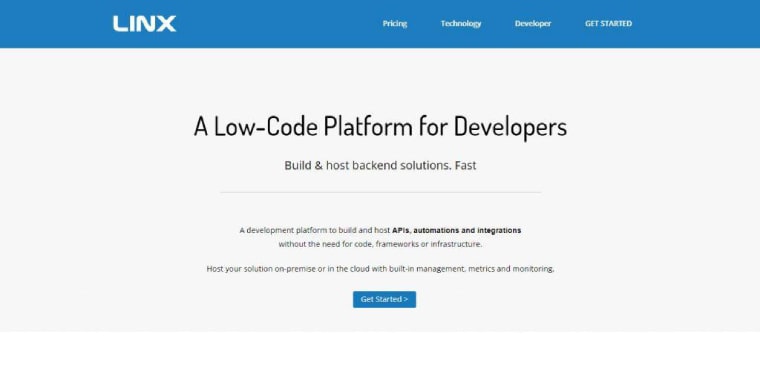
Mainly used for APIs, automation, and software development processes, Linx is a low-code tool. If you are willing to create automated backend apps or web services? Choose Linx.
Linux enables simplifying multiple operating systems that enable you to control as well as rewrite data across multiple systems in the development environment. Some of its astounding features include drag and drop prebuilt components used to design applications, performance analysis tools, visual debugging, enhanced functionality, faster software application delivery helping to develop event-triggered apps, database apps, and much more.
Features
- Simple, drop-and-drag UI that’s a breeze to use.
- There are over a hundred pre-made features and services that can speed up your projects.
- Deploy to a local or remote Linux Server with a single click from the IDE.
- Nearly all SQL and NoSQL databases, a wide variety of file types (text and binary), and REST and SOAP Web services may be used as inputs and outputs.
- Live, iterative logic debugging in real time.
- Timer, directory event, and message queue automation; web service exposure; API invocation through HTTP queries.
1.2 NetBeans
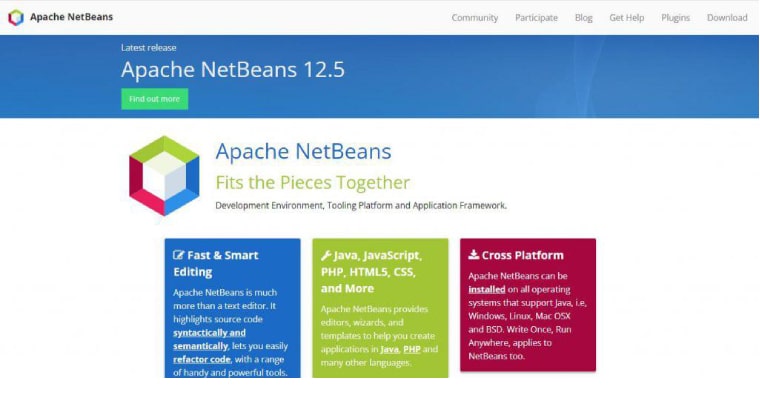
Are you looking for an open-source software development tool written in Java? If yes, NetBeans is one of the best software tools to consider to develop the best web and desktop applications. In terms of drag-and-drop software development tools, NetBeans is software developers’ top pick. With the help of NetBeans, you can easily develop any kind of application, whether it’s for mobile or the web. Supports cross-platform and is considered for smart code editing, writing bug-free codes, easy project management procedures, and quick graphical user interface development. Source-Code analyzers, editors, and converters are offered by NetBeans IDE. Here understanding the structure of the application is no big deal. This software development tool offers great support.
Features
- Support for modifying code quickly and effectively.
- Simple and Effective Method for Managing Projects.
- Designing Interfaces for Users Quickly.
- Aids in the creation of stable programs.
- Superior support for C/C++ and PHP is available in the NetBeans IDE.
- It’s compatible with Linux, Mac OS X, and Windows computers as long as they have Java installed.
1.3 Azure
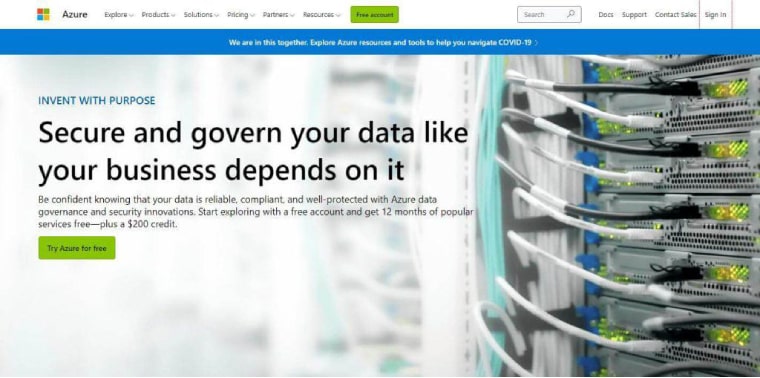
One of the leading cloud tools for software development services is Microsoft Azure. This one is widely being used to build, deploy as well as manage progressive web apps. It supports a wide number of programming languages, devices, frameworks, and operating systems.
Thomas Arp, a senior developer shared his experience working with all 3 clouds. Here’s what he said
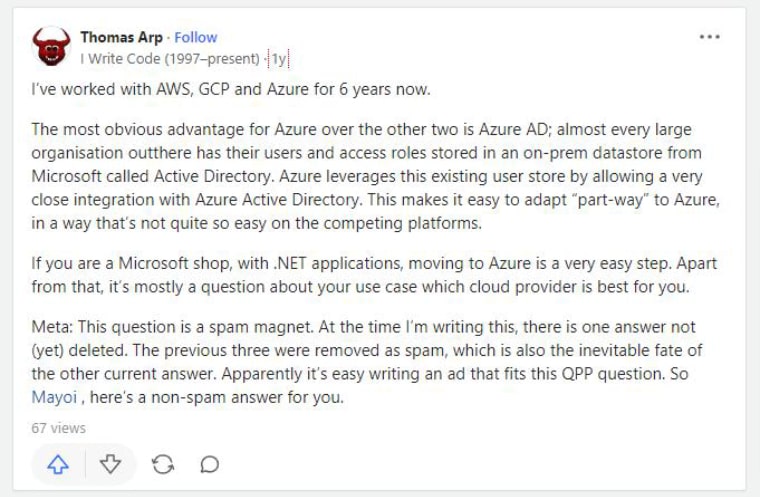
Features
- Almost every language used to create a website application is supported.
- Full software development kit that supports all the major IDEs.
- Azure is a one-stop shop for app development, deployment, and management.
- The cache in Azure guarantees speedy data access during development.
- Strong support for Microsoft Business Intelligence.
1.4 Github

Being the most popular software development platform across the globe. It is basically a web-based Git repository hosting service where users can find codes pretty easily. It allows both code review and code management.
In addition, Github’s community is pretty big. So if you are looking for collaborative development, look no further than here as it also provides high-end project management tools. Below image show why developers should use Github.
Features
- Use GitHub’s project management features to effortlessly collaborate, maintain cooperation, and complete tasks.
- Simple instructions and well-written code go hand in hand.
- It’s one of the greatest software development tools there for keeping everything in one convenient location.
- Developers may now host their docs in the same places they save code.
1.5 Jira
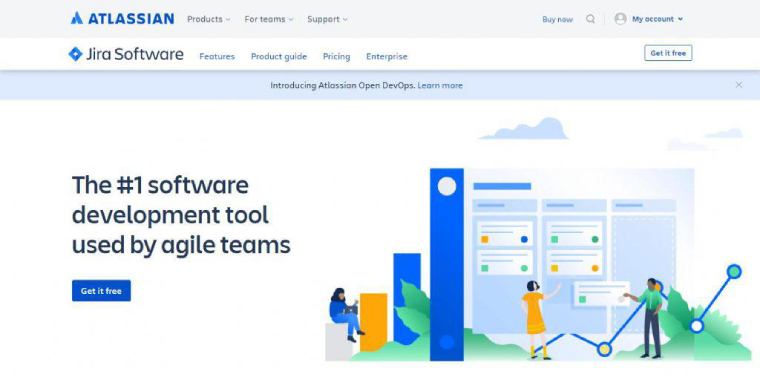
Are you seeking out a project management tool that supports agile methodology to a great extent? Jira is the name to consider when you are looking for a tool that keeps a fair track of project backlog or aids in resolving bugs and patches.
Jira, not just assists software development teams in developing software but also offers requirements and testing management. More or less, DevOps teams can conduct the software deployment process pretty easily. Featuring remote APIs, the tool can be well-integrated with almost all third-party applications, this does result in delivering a work experience like never before. It provides a free plan for up to 10 users.
Features
- It’s easy to tailor this tool to your own needs, and it already includes several capabilities that are standard throughout all stages of development.
- Work in development, reports, backlogs, etc. may all be generated and managed with Jira.
- Scrum boards, Kanban boards, interaction with GitHub, disaster recovery, code integration, handling portfolios, scheduling sprints, project management, etc. are just a few of the many useful features offered by Jira software.
- Jira is compatible with both Microsoft Windows and Linux/Solaris.
1.6 Jenkins
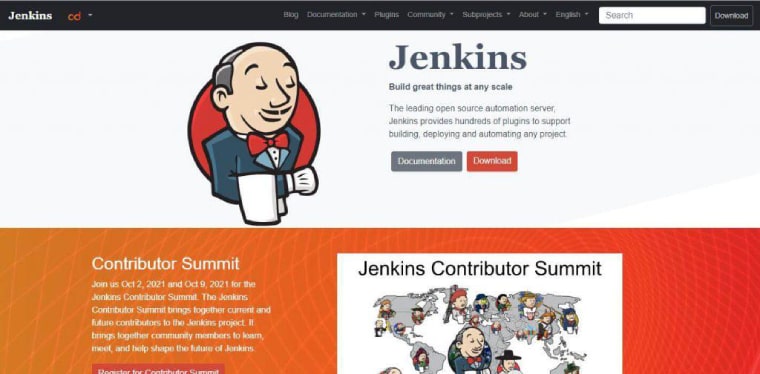
Mainly used to conduct high-end back-end software development for our next contender. Now does your application constantly refer back to the server? If so, Node.js is highly advisable. Because it is the same javascript running on the front and back end
Whether you want to develop chats, social media, or any other online browser-based games, Node.js serves it all!
Features
- Jenkins is a Java-based application that requires no further dependencies and comes with prebuilt binaries for Windows, Mac OS, and Unix-like platforms.
- Jenkins’ online interface, which includes error checks and a built-in help feature, makes installation and configuration a breeze.
- The Update Center has hundreds of plugins that connect to various components of the continuous integration and continuous delivery infrastructure.
- Jenkins’ plugin design allows for practically infinite customization and expansion of the program’s functionality.
1.7 Node.js
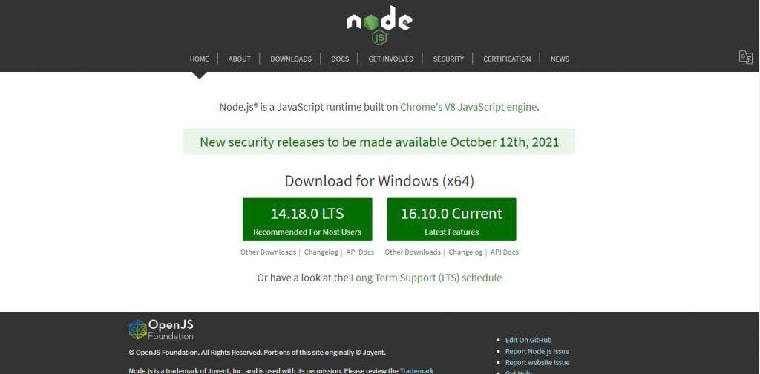
Mainly used to conduct high-end back-end software development for our next contender. Now does your application constantly refer back to the server? If so, Node.js is highly advisable. Because it is the same javascript running on the front and back end
Whether you want to develop chats, social media, or any other online browser-based games, Node.js serves it all!
Features
- Applications built using Node.js can be used with every major operating system.
- Because of its event-driven and non-blocking I/O approach, Node.js is both compact and fast.
- Developers use Node.js to create JavaScript-based server-side applications.
- Modules written in Node.js are used to construct the back-end architecture and integrate it with the front-end platforms quickly and efficiently.
- The node.js package has the most extensive collection of accessible open-source libraries.
- Node.js is used by many different types of businesses and organizations, including IT firms, software developers, and both small and large businesses.
1.8 IntelliJ IDEA
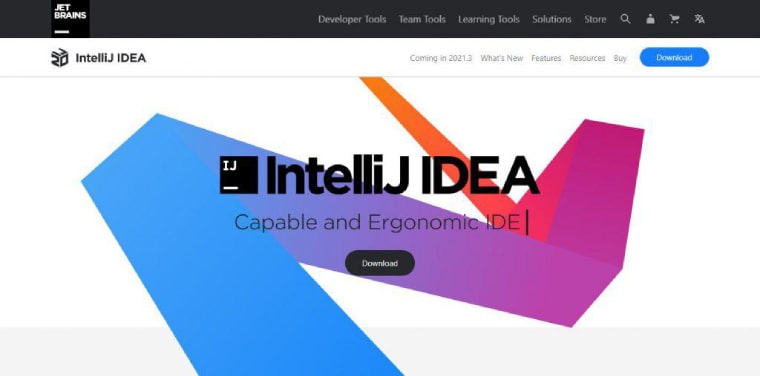
As the name implies, this software development tool is a java-based IDE for developing Java applications. Built-in version control, an integrated terminal, debuggers, and other development tools are all included in this JVM-focused IDE. Some of its core components include -framework-specific support, intelligent code completion, error analysis, in-depth coding aid, rapid navigation, etc.
Features
- You can choose your programming language, framework (such Maven or Gradle), and Java Development Kit (JDK) version in the New Project wizard. The IDE will automatically download the necessary JDK if it is not already installed.
- From quickly seeing recently used files to launching and troubleshooting your project, IntelliJ IDEA provides keyboard shortcuts for nearly every task.
- There are more than a hundred available interface custom themes that may be used to fully revamp the appearance of your IDE.
- You may alter the text size in the editor, adjust the tool windows, and change the colors used for the various UI components.
- It has a rich ecosystem of plugins that covers almost any scenario a programmer may face.
1.9 Bootstrap
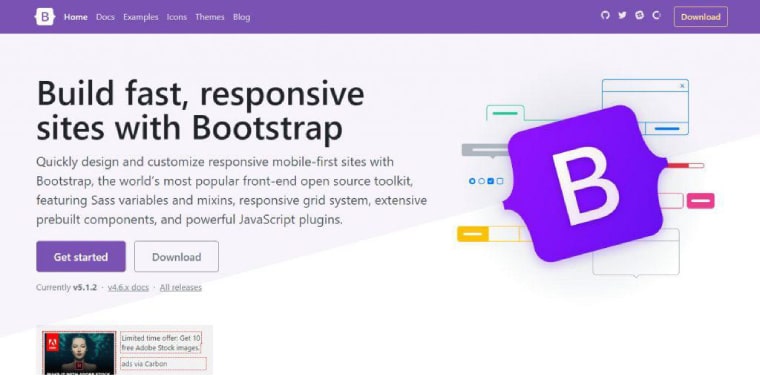
Bootstrap is a front-end framework mainly used to optimize JavaScript, HTML, and CSS. The main objective here is to come up with a user-friendly site and make it well-optimized.
Features
- With Bootstrap, you may use pre-built sections of code.
- It guarantees uniformity no matter who is doing a certain task.
- It provides a broad catalog of available parts.
- Standard CSS for use with most HTML elements.
- Bootstrap’s flexibility makes it easy to tailor it to the requirements of each given endeavor.
1.10 Chrome DevTools
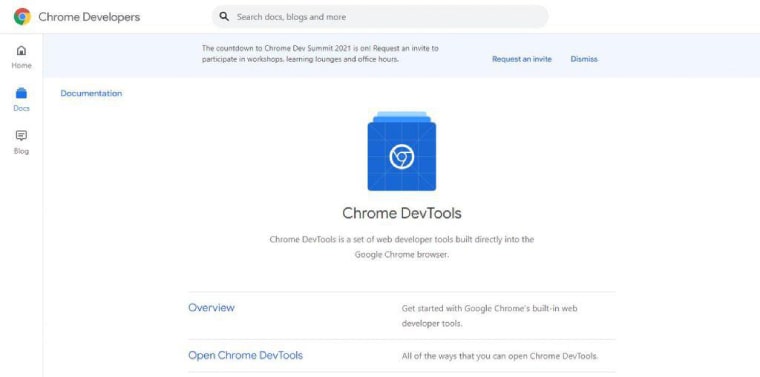
Call it a comprehensive toolkit or a rare mix of debugging systems, Chrome Dev tools is another name to take into account when considering top software development tools around. Now, what exactly does this one do? You may ask? Well, it enables one to make changes in real-time.
In case of any blunder or issue, the situation can be rectified then and there. Apart from this, you can catch non-working plugins without any hassle here. Overall, Chrome Dev Tools are mainly used to check whether the frontend is working at par or not.
Features
- Preserves logs in the console.
- You can catch events to inspect where and what runs on interactions.
- For DOM, you can simply add a breakpoint for the element and let DevTools handle the rest.
- With the help of the coverage tool, you can profile your resources and see which lines are not executed.
- You can address unnecessary repaints issues and see which elements trigger them by enabling paint flashing in the Render tab.
1.11 Vim
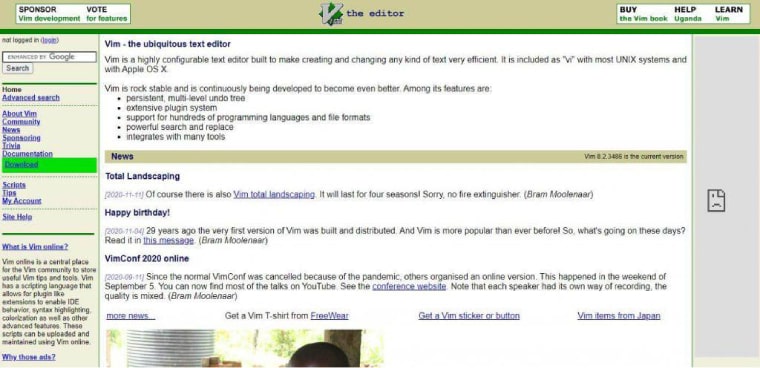
This one is a text editor, i.e. available for free. Just like Notepad, Sublime Text, Atom and Vim have slowly created their place in the software development industry. But what makes Vim a Cut-above from the rest of the crowd? Well, first and foremost, this one is great when it comes to efficiency. The editor offers customization according to your typing needs and criteria.
And second is ubiquity. The editor is pretty much compatible with any OSes whether you are using Mac or Linux or Windows operating systems. Over the years, Vim has been pretty much in demand due to its unimaginable versatility and high speed. The only drawback is its steep learning curve. If that’s okay for you, you must definitely go for this.
Features
- Superior capacity for searching and replacing.
- Code review debugging mode.
- Hundreds of languages and file types are supported.
- Add-ons that boost its capabilities.
- Agile and quick to react.
- Compact.
1.12 AWS ECS
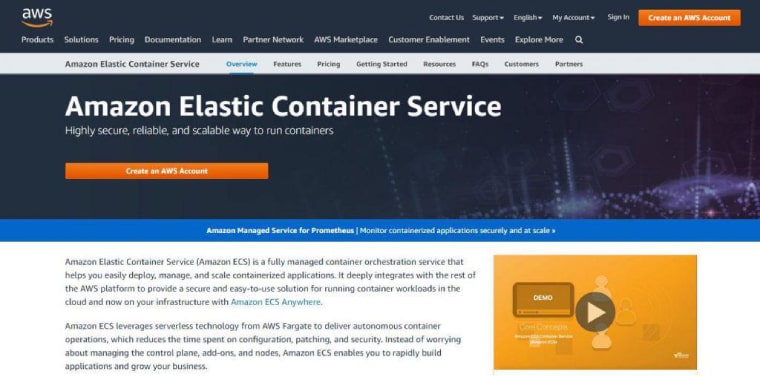
If you are looking for a cloud computing service then Amazon Elastic Container Service mainly known as AWS ECS is the right choice to hop upon. Here software development companies can seamlessly make any application run in the cloud. Yes, you read it right! This means no need to conduct environment configuration.
Here anything is possible whether you want to host a website or run complicated codes. Do you know the best use cases of AWS ECS? When combined with machine learning or microservices, virtual machines, migrate applications to the cloud, run batch workloads, etc.
Features
- You may set up Amazon EC2 Auto Scaling to automatically increase or decrease your Amazon EC2 capacity based on the criteria you specify.
- Provisioning computing capacity across EC2 instance types, Availability Zones, and purchasing models may be done with a single API request using Amazon EC2 Fleet, allowing for improved scalability, performance, and cost efficiency.
- There are two ways in which the Optimize CPUs function grants you more power over your Amazon EC2 instances.
- Your Amazon EC2 instances with Amazon EBS storage can be put into sleep mode and then resumed.
- Improved networking allows for rapid data transfer at low latency.
- The Elastic Fabric Adapter allows for intensive inter-node communication.
- Controllable IP Address Flexibility for Dynamic Cloud Services.
- High-performance computing clusters offer both high throughput and low latency.
- Using Amazon Web Services-Hosted Services AWS PrivateLink makes this process simple and safe.
1.13 Buddy
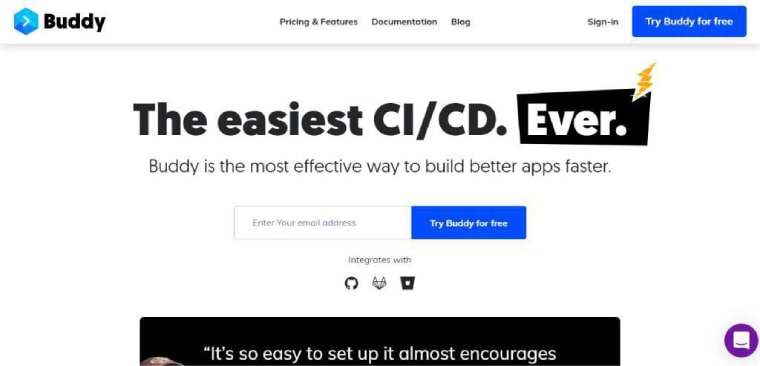
Buddy is a multi-purpose ground-breaking software development tool that is used to test, build, deploy and integrate multiple elements and their actions. Buddy as a development tool can make the tiresome parts of any project very simple and easy from website delivery to app deployments, from builds to testing. Buddy is the most efficient approach to creating great apps in less time. Even the most complex CI/CD procedures only take a few minutes to set up.
If we go by the characteristics of Buddy then we can say it is a champion in DevOps adoption Buddy is the fastest because of smart change detection, cutting-edge caching, parallelism, and all-around improvements. Your stack is always a click away from Docker, Kubernetes, Serverless, and Blockchain. Buddy is a low-friction automation tool for web and mobile developers, designers, and QA teams that makes DevOps simple. Buddy allows you to build, test, and deploy apps and websites faster with only a few minutes of setup.
It supports a wide range of frameworks, task managers, and programming languages, and builds are completed in independent containers. The integration feature is the icing on the cake. It works with a variety of software development platforms, including WordPress, Google, and AWS.
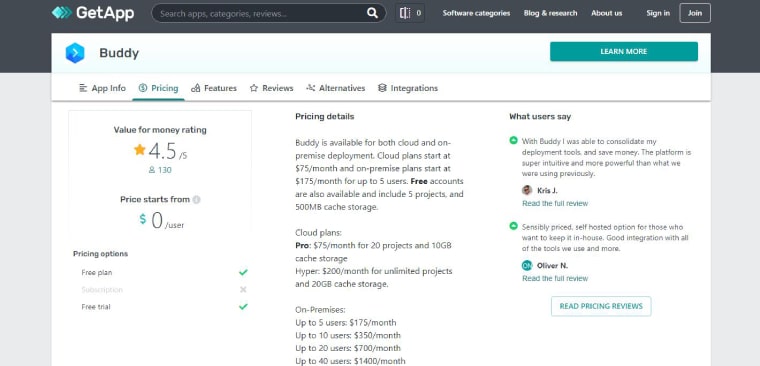
According to GetApp, Buddy has 4.5 star rating which makes it one of the most popular software development tools in the market.
Features
- Setting up is quick.
- Fast rollouts based on existing changesets.
- Allows for the use of several programming languages, frameworks, and schedulers.
- YAML configuration and parallel processing support.
- Capacity to work along with other programs.
1.14 HTML5 Builder
HTML5 Builder, a tool for developing mobile and web applications, has a lot to offer. It’s flexible, and it’s one of the fastest software development tools on the market. You can now build online and mobile apps with a single codebase using web standards, and deliver them to consumers via desktop and mobile operating systems, web browsers, as well as natively “on device” via Apple, Android, and Windows Phone app stores.
HTML5 Builder is a developer force multiplier that enables Enterprises and ISVs to graphically design dynamic content apps for the Web, iOS, Android, and Windows Phone using a single codebase and web client standards like HTML5, CSS3, and JavaScript. It makes cross-platform program development simple and effective.
Features
- Cloud services allow for the rapid development of cross-platform apps.
- The use of a unified visual framework hastens the development process.
- It’s one of the greatest features of the program for facilitating communication and cooperation between the design and development teams.
- Construct custom web and mobile apps for businesses and ISVs.
- Use HTML5 Builder’s geolocation components to create location-aware browser and mobile apps.
1.15 Zend Studio
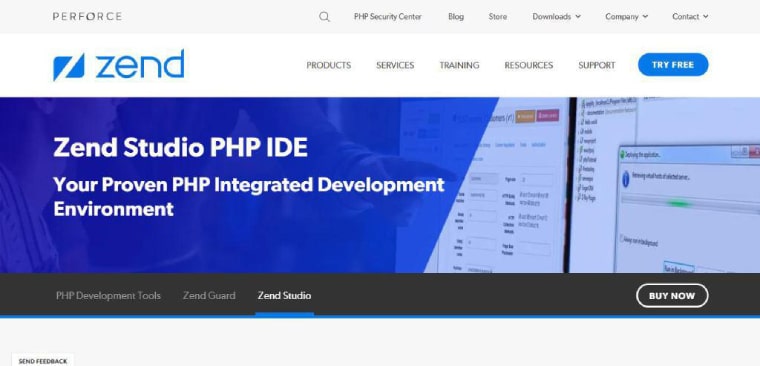
Software developers can code quicker and debug even simpler using the famous tool- Zend Studio. It is a next-generation PHP IDE that is aimed to help developers create apps that will increase their productivity. It’s one of the better development tools because it adjusts to the underlying operating systems’ DPI settings.
Zend Studio is compatible with Zend Framework, Laravel, and Symfony PHP frameworks. As a result, you may utilize Zend Studio’s built-in developer tools to create framework-based applications with proper structure, files, and directories.
Features like automated module generation, helpers, controllers, and enhanced content assist for services and variables are also available. Indexing, validation, verification, and searching for PHP code have all seen significant efficiency increases.
It provides many debugging options using Xdebug, Zend Debugger, and Z-Ray integration tools. Zend is also one of the most preferable programming tools that support development tools including Docker and Git Flow.
Features
- Increased speed in indexing, validating, and searching for PHP code means you can get more work done in less time.
- Xdebug, the Zend Debugger, and Z-Ray are all integrated to aid in the debugging process.
- The vast Eclipse ecosystem offers a wide variety of plugins.
- It’s a great programming environment that works well with other development tools like Docker and Git Flow.
- Use any server to launch PHP apps in the cloud, including AWS and Azure.
1.16 Axure
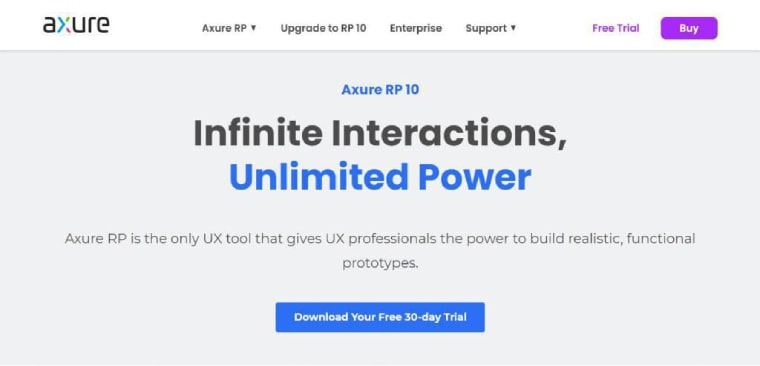
Axure is another prominent name in the world of IDEs. There are compelling features of Axure that make it different from other IDEs. It has more than expected capabilities that allow businesses and developers to easily build wireframes, documentation, and prototypes without having to write code.
Some of the inevitable features include:
Inbuilt Features and Libraries- Creation of Flowcharts, wireframes, mockups, user journeys, personas, concept boards, and more with this fast and flexible diagramming tool. Create diagrams quickly by dragging and dropping objects from built-in or custom libraries. Then add fills, gradients, line styles, and text formatting to make it seem nice.
Simple to Distribute: Axure can easily publish your diagrams and prototypes to Axure Share. You can utilize it on the cloud or on-premises with the click of a button. Others can view your project in a browser by sending a link. Use a browser or the Axure Share App for iOS and Android on mobile devices.
Easier Team Collaboration: Axure RP enables several users to use the same file at the same time for simpler collaboration easier for your team. To handle modifications, create a “Team Project” using Axure Share or SVN and use a check-in and check-out method. In addition, team projects keep track of modifications with notes for each check-in.
Features
- The prototype is created in HTML and a shareable link is provided by Axure RP.
- It’s one of the greatest collaborative development environments where several people may edit the same file at once.
- It’s compatible with Microsoft’s IIS and either MySQL or SQL Server as a database.
- It’s useful for making and managing collections of widgets.
1.17 Zoho Creator
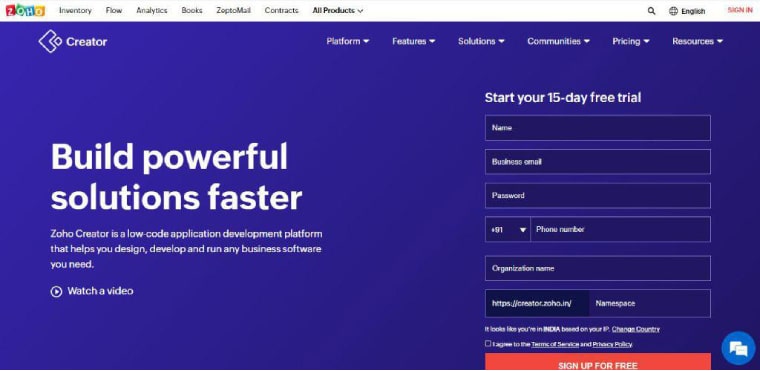
Zoho Creator is a low-code platform that helps you build sophisticated enterprise software applications 10x quicker by enabling rapid development and delivery of online and mobile applications. To create an application, you no longer need to write countless lines of code.
Artificial Intelligence, JavaScript, Cloud functionalities, third-party integrations, multi-language support, offline mobile access, payment gateway integration, and more are all included.
Some of the notable features of Zoho Creator include:
- With little work, you can create more applications.
- Connect your business data and collaborate with colleagues from different departments.
- Produce informative reports.
- Get access to mobile apps right away.
- Uncompromised safety and highest safety measures.
Features
- Build more useful software with less time spent on it.
- Integrate your organization’s data and facilitate teamwork.
- Compile informative reports.
- Get immediate access to your phone’s apps.
- Safety that cannot be breached.
1.18 BitBucket
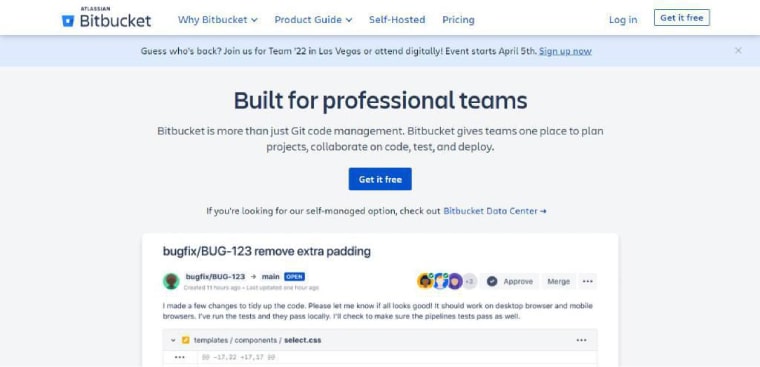
BitBucket is a service that works as a repository for source code and development projects. It’s a collaborative and communication web-based control system for development teams.
The users of Bit bucker can integrate many repositories within a project. This is because Bitbucket allows them to focus on the end product or project. BitBucket offers capabilities such as unlimited private repositories, customizable deployment strategies, and supercharged code collaboration. Integrations, code search, Bitbucket pipelines, smart mirroring, issue tracking, Git huge file storage, and other services are also supported.
Is far more adaptable, with access to a larger number of version control systems.
Has a sophisticated Jira integration that simplifies task tracking.
There’s a strong Trello integration.
Depending on your needs, it may have a better cost.
Features
- Control who may make modifications to the code by granting them access to the appropriate branches.
- By grouping code into distinct projects, it allows development teams to better concentrate on a single objective, deliverable, or procedure.
- It can exhibit build results from a continuous integration system.
- The software development process can be streamlined by integrating this tool into the present workflow.
1.19 Cloud9 IDE
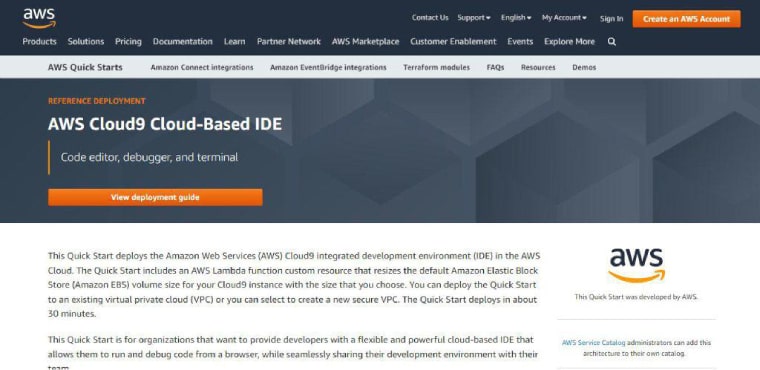
Customers can instantly clone complete environments using this online integrated environment software. Cloud9 was the first integrated development environment (IDE) to be hosted on the cloud. Eclipse Che is a Kubernetes-native IDE that is available as an open-source project. Because Eclipse Che is developed on top of Eclipse Theia, the appearance and feel of many browser-based IDEs may be familiar to many developers. Eclipse Theia is an open-source project that creates a foundation for creating browser and desktop IDEs that can be extended. Python, Perk, Ruby, PHP, C, and JavaScript are just a few of the programming languages supported by Cloud9 IDE.
It’s simple to use, and you may utilize it to save time by setting breakpoints. The Code Completion part is the cherry on top, as it provides solid code completion ideas.
In contrast to the majority of other alternatives, this specifically focuses on new attributes of functionalities and users. Its compelling inbuilt features allow users to innovate, create and clone the entire development environment.
Features
- When it comes to writing, executing, and debugging code in the cloud, Cloud 9 IDE is the web-based tool you need.
- Users of Cloud 9 have access to serverless apps that facilitate the seamless transition between remote and local testing and debugging.
- Cloud 9 is a potent tool because of its many useful capabilities, such as code completion recommendations, debugging, file dragging, etc.
- For online and mobile developers, Cloud 9 is an IDE that facilitates teamwork.
- AWS Cloud 9 allows developers to collaborate on environments with their coworkers.
- The full development environment may be recreated with Cloud 9 IDE.
1.20 Codenvy
Codenvy is a cloud development environment. It is a concept that describes the reactions and feelings of companies that have adopted cloud culture. These companies pay them a visit, take a tour of the data center, and then consider whether they should do it as well. They waste a lot of time and money running after opportunities that don’t exist for them. As you can see in the below image, Codenvy has 297 stars and 121 forks in GutHub.
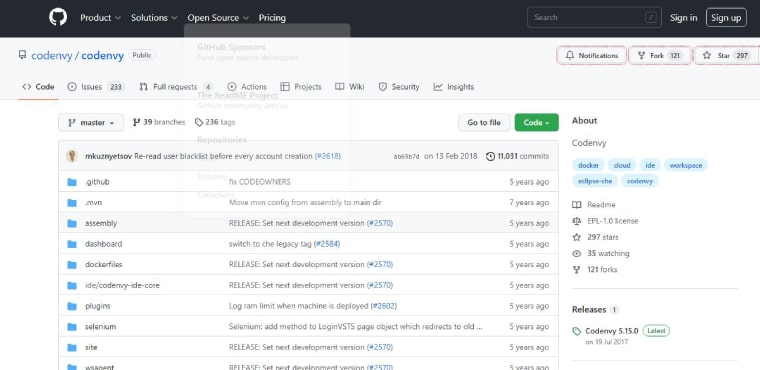
Developers can use Codenvy virtual workspaces to edit, save, build, and debug code as if it were local. browser-integrated development environment (IDE) or a desktop IDE can be used in workspaces. Administrators can define user permissions and resources for each user, and workspaces can be shared inside teams or with external users. JIRA and Jenkins are two examples of integrations. Condenvy is a subscription-based service. Email and Github support are both available.
Features
- Codenvy is a cloud-based IDE, so there’s no requirement to set it up or worry about installing anything on your computer.
- Jira, Jenkins, Che extension for Eclipse, and any proprietary toolchain may all be connected with Codenvy.
- A wide variety of IDE add-ons, Eclipse Che commands, stacks, editors, assemblies, RESTful APIs, and server-side extension plug-ins may be used to personalize Codenvy to suit your specific needs.
- Codenvy is compatible with Windows, Mac OS, and Linux, among others. It’s also compatible with both public and private cloud environments.
- Codenvy’s command-line installers may be utilized in any setting.
1.21 GeneXus

GeneXus is the last one on the list, as GeneXus is a high-end intellectual platform that can help you to design apps and systems. These were aimed to automate the development process, maintain programming languages, and databases, and manage other critical applications across cross-platform
As per market and technology changes, all the GeneXus-modeled applications can be rapidly modernized as per business changes. You can also develop an app in GeneXus using the most recent programming language and instantly deployed it to every major platform on the market.
GeneXus’ vision is founded on more than three decades of experience in the development of autonomous generation and application development tools. If you want to learn how to use GeneXus then the video below can be helpful.
Apps offering multi-user experiences. Create a model once, then generate it on various platforms for apps to be responsive as well as progressive.
Maximum adaptability-The most databases are supported on the market and they possess capabilities for interoperability in system integration.
Future-ready apps- Create apps that can evolve over time and can automatically switch across technologies and platforms. GeneXus helps with business management, and process management and also integrates BPM modeling for digital process automation.
Features
- Generating programs automatically by employing AI.
- A variety of experiences in one app. Create a model once, then output to several platforms (iOS, Android, Apple TV, chatbots, virtual assistants, etc.).
- Maximum adaptability.
- The widest range of database systems is supported.
- System integration interoperability capabilities.
- Long-term system evolution and automated platform/technology switches are possible.
- Assistance in Managing Business Procedures.
- Automation of digital processes with unified BPM modeling.
- Modularity in deployment.
- Applications can be deployed locally, on the cloud, or in a hybrid configuration.
- Integrated application security module.
2. Types of Software Development Tools
2.1 Integrated Debugging Environment (IDE)
The IDE is such a kind of software development tool that more web developers love spending time with. It’s more like killing two birds with an arrow, a code editor, and a debugging interface. In fact, an Integrated development environment also acts as an integration point for several other types of software development tools around.
2.2 Build Tools
Do you think that Build tools are just limited to a compiler or a link editor? Nope! It comprises every technical aspect that assists in translating human languages to the ones which can be understood by a machine. Build tools do assist well in managing dependencies.
2.3 Tools to Support Methodology
It may quite interest you to know that software development methodologies include tools that are pretty simple and easy to use. For example, If you want to organize use cases or track progress, or monitor significant growth, several software tools are available.
2.4 Source Control
Now managing access to the source code of the project can turn out to be extremely critical at times. In fact, web developers are always set for managing concurrencies so that one developer’s changes don’t overwrite other developers’ work. Also, source control is pretty much known for creating branches as well as merging changes between them.
2.5 Testing Tools
Another interesting bunch of software development tools falls under the testing realm. The key objective here is to meet the end requirements and is free of defects. Tools can be used to conduct a wide range of testing as well as can be used to automate the task of performing each test.
3. Conclusion
Software developers have different needs and fortunately with so many software programming tools around it is possible to work on multiple software projects. Above mentioned software developer tools can help make the software development process quite simple and easy. Of course, you can select a software development tool on the basis of reviews and recommendations but still, you need to dig in deep before making a choice as not everyone’s needs are the same. So choose a software programming tool wisely!






It provided valuable insights into different tools for different stages of the software development life cycle, which is useful for both developers and businesses. I especially appreciated the pros and cons of each tool, which helped me to make an informed decision about which tool to choose for my project.